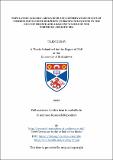Files in this item
Population ecology, behaviour and conservation status of common bottlenose dolphins (Tursiops truncatus) in the Gulf of Trieste and adjacent waters of the northern Adriatic Sea
Item metadata
| dc.contributor.advisor | Hammond, Philip Steven | |
| dc.contributor.author | Genov, Tilen | |
| dc.coverage.spatial | 280 | en_US |
| dc.date.accessioned | 2023-03-31T09:31:56Z | |
| dc.date.available | 2023-03-31T09:31:56Z | |
| dc.date.issued | 2022-11-29 | |
| dc.identifier.uri | https://hdl.handle.net/10023/27309 | |
| dc.description.abstract | This thesis aims to explore a combination of distinct but interconnected aspects of dolphin population ecology, behaviour and interactions with human activities in the Gulf of Trieste and adjacent waters of the northern Adriatic Sea. Boat surveys, photo-identification techniques and biopsy sampling between 2003 and 2018 were used to investigate social structure, interactions with local fisheries, isotopic niche variation and levels of organochlorine contaminants, and estimate dolphin abundance. The population was found to be structured into distinct social clusters, two of which displayed marked differences in fisheries-related behaviour and temporal partitioning previously unknown for this species or marine mammals generally. Stable isotope analysis showed isotopic niche differences among social groups. Levels of polychlorinated biphenyls (PCBs) were high, with evidence of maternal offloading of these pollutants to offspring, but no differences among social groups. Abundance estimates suggest that the total abundance of bottlenose dolphins in the study area during 2013–2018 ranged between 161 (95% CI = 153–170) and 245 (95% CI = 219–273). Finally, a novel method for individually identifying dolphins by facial features is described, which can complement existing photo-identification techniques. Together, these results provide a reasonably holistic picture of the dolphin population inhabiting the Gulf of Trieste and provide insights into social, ecological and anthropogenic drivers of its population dynamics. This study extends the available knowledge on Adriatic dolphins and provides a baseline for further studies. | en_US |
| dc.language.iso | en | en_US |
| dc.subject | Bottlenose dolphin | en_US |
| dc.subject | Tursiops truncatus | en_US |
| dc.subject | Population ecology | en_US |
| dc.subject | Behaviour | en_US |
| dc.subject | Conservation | en_US |
| dc.subject | Adriatic Sea | en_US |
| dc.subject | Mediterranean Sea | en_US |
| dc.subject | Social structure | en_US |
| dc.subject | Social network | en_US |
| dc.subject | Fisheries | en_US |
| dc.subject | Stable isotopes | en_US |
| dc.subject | Foraging ecology | en_US |
| dc.subject | Pollutants | en_US |
| dc.subject | Organochlorine contaminants | en_US |
| dc.subject | PCB | en_US |
| dc.subject | Toxicology | en_US |
| dc.subject | Abundance | en_US |
| dc.subject | Survival | en_US |
| dc.subject | Mark-recapture | en_US |
| dc.subject | Photo-identification | en_US |
| dc.subject.lcc | QL737.C432T5 | |
| dc.subject.lcsh | Bottlenose dolphin--Adriatic Sea Region | en |
| dc.subject.lcsh | Bottlenose dolphin--Ecology--Adriatic Sea Region | en |
| dc.subject.lcsh | Bottlenose dolphin--Behavior--Adriatic Sea Region | en |
| dc.subject.lcsh | Bottlenose dolphin--Conservation--Adriatic Sea Region | en |
| dc.subject.lcsh | Population biology | en |
| dc.title | Population ecology, behaviour and conservation status of common bottlenose dolphins (Tursiops truncatus) in the Gulf of Trieste and adjacent waters of the northern Adriatic Sea | en_US |
| dc.type | Thesis | en_US |
| dc.type.qualificationlevel | Doctoral | en_US |
| dc.type.qualificationname | PhD Doctor of Philosophy | en_US |
| dc.publisher.institution | The University of St Andrews | en_US |
| dc.identifier.doi | https://doi.org/10.17630/sta/380 |
This item appears in the following Collection(s)
Items in the St Andrews Research Repository are protected by copyright, with all rights reserved, unless otherwise indicated.

